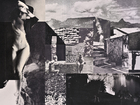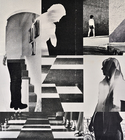text by Judy Annear
This is a story about decapitation and the sea among other things, and what can be done if anything.
They could have said but could not. Their lips are sealed and their eyes closed. They had turned away from the horror of what they saw they had made. The shattered ground and blasted trees, endless staircases, body parts. Standing in silence they are lost. Moths cling together. Men and women become each other, gracefully. They lie down and die for no reason having forgotten their ability to make anything. No, they sleep and dream then walk away ennobled by the half-life of the page and obsolete technologies. Where did they come from? What did they think they were doing?
They balance themselves between one thing and many things. There is the thought that they are stand-ins. They give the world other worlds then they float free out into the ether to be picked up by chance to engender another kind of puzzle. They are cinematic yet modest released from the constraints of the didactic. Undraped and laid down they are cut and sutured. They are situated elsewhere in time and space where they can speak, perhaps.
To cut is to interrupt, to disarm literally and figuratively. The clean, straight cut is quicker and less painful, just as symmetry provides balance. The cut interrupts the gathering of information. The information continues to be gathered differently. The cut removes something from its origins. The interruption is brief, tidy but cataclysmic. This is not a grid. The ground opens up and convention sleeps. If you turn your head, you will see something else. Time passes even if a split second from one thing and another. Interruption is normal but you don’t like it necessarily. Between the cut and the thing something else appears. A new memory.
Memories are homely because we live with them. Even if we don’t like them. Memories are a pastiche. We slide things together without thinking about it. We pile them up, shuffle them, forget. Pieces in a puzzle, a deck of cards, a cut up. Sometimes we think a snapshot or a reproduction in a magazine or book is our memory. Perhaps it is. Perhaps it isn’t. It’s no longer possible to tell once we have looked at something.
Structure is helpful. Structure is order, scale, support. What happens when an architecture comes into tension with what it supports? Formal structures can be like memories, they are homely. If they are enveloping, we can feel safe. But what if there is precarity instead of balance, instead of sleep there is death, instead of structure there is ruin. The earth opens beneath us.
Gathering and repurposing is partial regardless of form. How to intervene and reflect that partiality? The order of gathering and repurposing has a rhythm. When things come into contact with each other they can be directed in multiple ways. They move together or apart. Movement in thought and feeling occurs when images meet each other. They come from time and they can step outside. They enlarge the treasure that is psychic space. The body carries the weight of thinking and feeling.
After the first world war when suturing men was common, montage came into existence. Bodies and heads needed work. They were never one thing anyway.
The order of the cut gives purpose just as time is not a commodity. In words there is parataxis, cut up. In images there is collage, montage, jump cut. Because images can’t reflect facts precisely, they are inaccurate. The facts are infinite as are the inaccuracies. Working with inaccuracies is inventive. There is a slippage in time and space. Images bleed into each other, and into and out of us.
These streams don’t flow into one definitive sea; these rivers have no permanent banks; this body, no fixed borders. This unceasing mobility, this life.
— Luce Irigaray
Judy Annear is a writer, researcher and Honorary Fellow at The University of Melbourne School of Culture and Communication.
References
Luce Irigaray, ‘When Our Lips Speak Together’, Signs, vol. 6, no. 1, Autumn 1980, pp. 69-79.
Lyn Hejinian, ‘The Orders of Interruption’, Aerial 10, 2016, pp 63-79.
Samuel Beckett, The Complete Short Prose 1929-1989, Grove Press, New York, 1995.

















